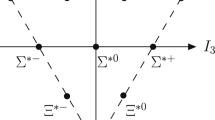Summary
Single-quark scattering contributions are considered in the case of ground-state decuplet baryon production. It is shown within the framework of an explicitly covariant approach that the spin consequences of the quark additivity assumption hold in thet-channel helicity frame independently of much of the details of the model.
Riassunto
Si studiano i contributi dello scattering di un solo quark nel caso della produzione di barioni del decupletto dello stato fondamentale. Si dimostra che nel contesto di un approccio esplicitamente covariante, le conseguenze sullo spin dell’ipotesi dell’additività dei quark valgono nel sistema di elicità del canalet indipendentemente da molti dei dettagli del modello.
Similar content being viewed by others
References
A. Białas andK. Zalewski:Nucl. Phys.,6 B, 449, 465, 478, 483 (1968).
G. C. Fox:Phenomenology in Particle Physics (Berkeley, Cal., 1971), p. 743.
E. M. Levin andL. L. Frankfurt:Žurn. Ėksp. Teor. Fiz. Pis’ma,2, 105 (1965).
H. J. Lipkin andF. Scherk:Phys. Rev. Lett.,16, 71 (1966).
J. J. J. Kokkedee andL. Van Hove:Nuovo Cimento,42 A, 711 (1966).
M. Kupczynski:On the additivity assumptions, Warsaw University preprint (1971).
This is definitely true in oscillator models like for instance that of ref. (7).
R. P. Feynman, M. Kislinger andF. Ravndal:Phys. Rev. D,3, 2706 (1971).
Note that it was shown byFeynman, Kislinger andRavndal (7) that the argument of the nucleon magnetic moments in favour of the « light » quarks is not necessarily valid in relativistic quark models. In the oscillator model of ref. (7) the magnetic moments came out right without any assumption about the quark mass.
R. Delbourgo, M. A. Rashid, A. Salam andJ. Strathdee: inHigh-Energy Physics and Elementary Particles, Trieste Lectures, 1965 (Vienna, 1965), p. 455.
J. D. Jackson:Nuovo Cimento,34, 1644 (1964).
A. Białas, A. Kotanski andK. Zalewski:Nucl. Phys.,28 B, 1 (1971).
L. Stodolsky andJ. J. Sakurai:Phys. Rev. Lett.,11, 90 (1963).
G. Neuhofer, F. Niebergall, M. Regler, H. E. Stier, K. Winter, J. J. Aubert, X. De Bouard, V. Lepeltier, L. Massonnet, H. Pessard, M. Vivargent, T. R. Willitts, M. Yvert, W. Bartl andM. Steuer:Phys. Lett.,39 B, 271 (1972).
Author information
Authors and Affiliations
Additional information
To speed up publication, the author of this paper has agreed to not teceive the proofs for correction.
Rights and permissions
About this article
Cite this article
Montvay, I. The spin predictions of the relativistic quark model for baryon decuplet production. Nuov Cim A 14, 207–214 (1973). https://doi.org/10.1007/BF02734614
Received:
Published:
Issue Date:
DOI: https://doi.org/10.1007/BF02734614



